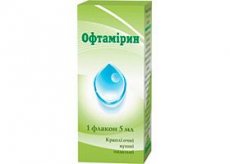Medical expert of the article
New publications
Preparations
Ophthalmic
Last reviewed: 23.04.2024

All iLive content is medically reviewed or fact checked to ensure as much factual accuracy as possible.
We have strict sourcing guidelines and only link to reputable media sites, academic research institutions and, whenever possible, medically peer reviewed studies. Note that the numbers in parentheses ([1], [2], etc.) are clickable links to these studies.
If you feel that any of our content is inaccurate, out-of-date, or otherwise questionable, please select it and press Ctrl + Enter.

Indications Ophthalmic
As an antiseptic, Ophthalin is used for ophthalmic diseases that develop due to bacterial, viral or fungal infections: conjunctivitis and blepharoconjunctivitis in acute and chronic form, keratitis (inflammation of the cornea), keratouveitis (inflammation of the cornea and vascular membrane of the eyeball), as well as eye injuries ( mechanical, thermal, chemical).
With surgical interventions in ophthalmology, Ophthalmic can be used to prevent infection.
Pharmacodynamics
Antiseptic effect Oftamirin provides the constituent compound of quaternary ammonium bases - miramistin. It is a cationic detergent (surfactant) with a strong antiseptic effect.
Due to the presence in the molecules of myramistin strongly basic groups, the drug acts on bacteria as a toxin: it oxidizes proteins and thereby destroys the integrity of cytoplasmic membranes of microbial cells. As a result, this leads to a violation of the osmotic balance of the microbial cell and its death.
Okomistin has a bactericidal effect against all gram-negative and gram-positive, anaerobic and aerobic, asporogenous and spore-forming bacteria and bacteroids, as well as the Herpes simplex virus.
Antifungal effect of the drug on the fungi of the genus Candida, Aspergillus, Penicillium, Rhodotorula rubra, Torulopsis gabrata, Malassezia furfur), as well as dermatophytes of the genus Trichophyton and Microsporum.
Dosing and administration
Drop Ophthalin should be instilled in the eye - directly into the conjunctival sac (the space between the eyeball and eyelid), without touching the eye, eyelashes and eyelids with the tip of the dropper. If the patient has contact lenses before digging in, they should be removed and put on after 15-20 minutes after the procedure.
The standard dose for infectious and inflammatory eye diseases is 1-2 drops per eye at least four times a day. The duration of treatment is determined by an ophthalmologist.
In case of a thermal or chemical burn, before use, Opharymine should be rinsed and then instilled 1-2 drops into each eye for 60 minutes to 120 minutes every 10 minutes.
Use Ophthalmic during pregnancy
Use during pregnancy and lactation is possible, but it should only be prescribed by the attending physician - in case of emergency.
Attention!
To simplify the perception of information, this instruction for use of the drug "Ophthalmic" translated and presented in a special form on the basis of the official instructions for medical use of the drug. Before use read the annotation that came directly to medicines.
Description provided for informational purposes and is not a guide to self-healing. The need for this drug, the purpose of the treatment regimen, methods and dose of the drug is determined solely by the attending physician. Self-medication is dangerous for your health.


 [
[